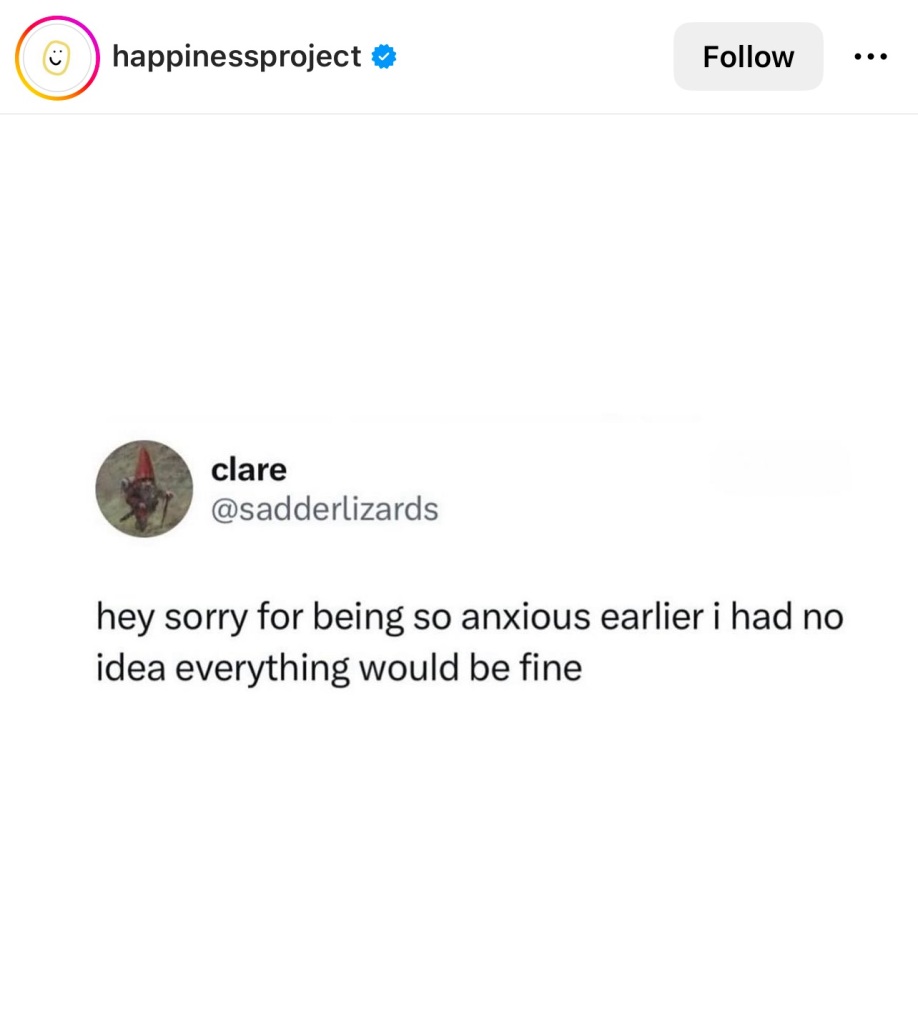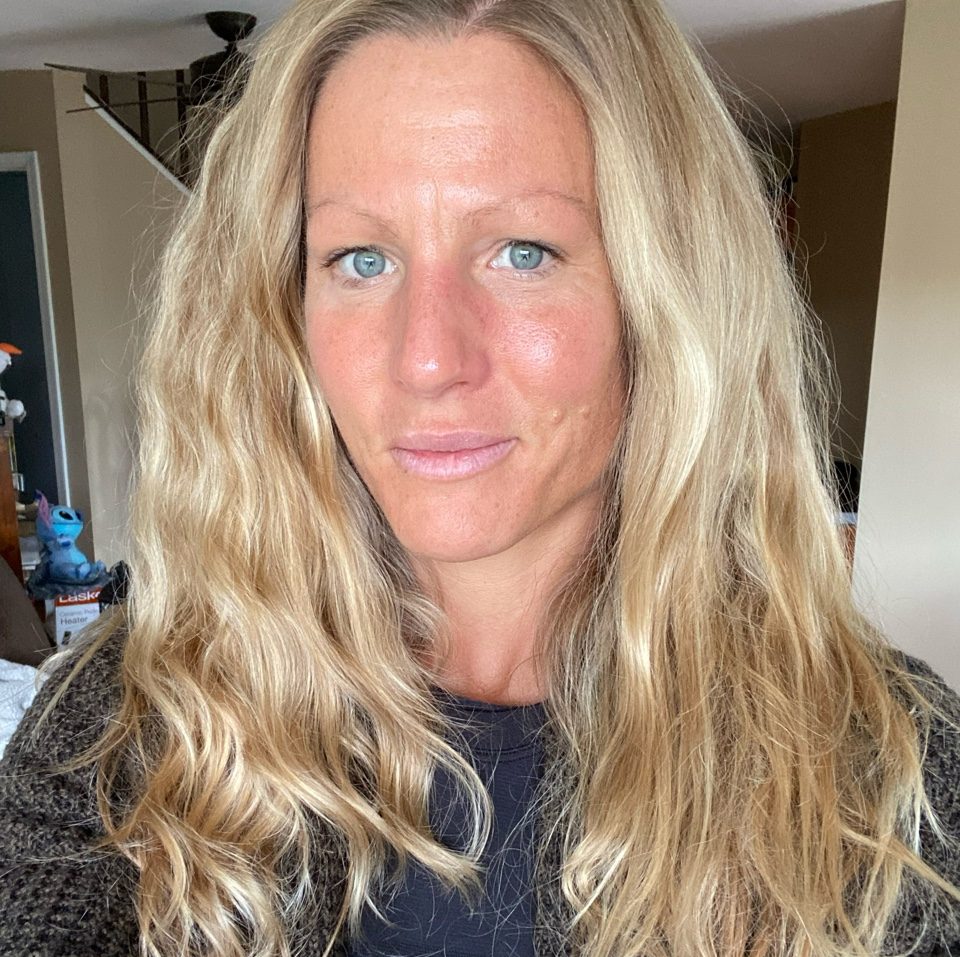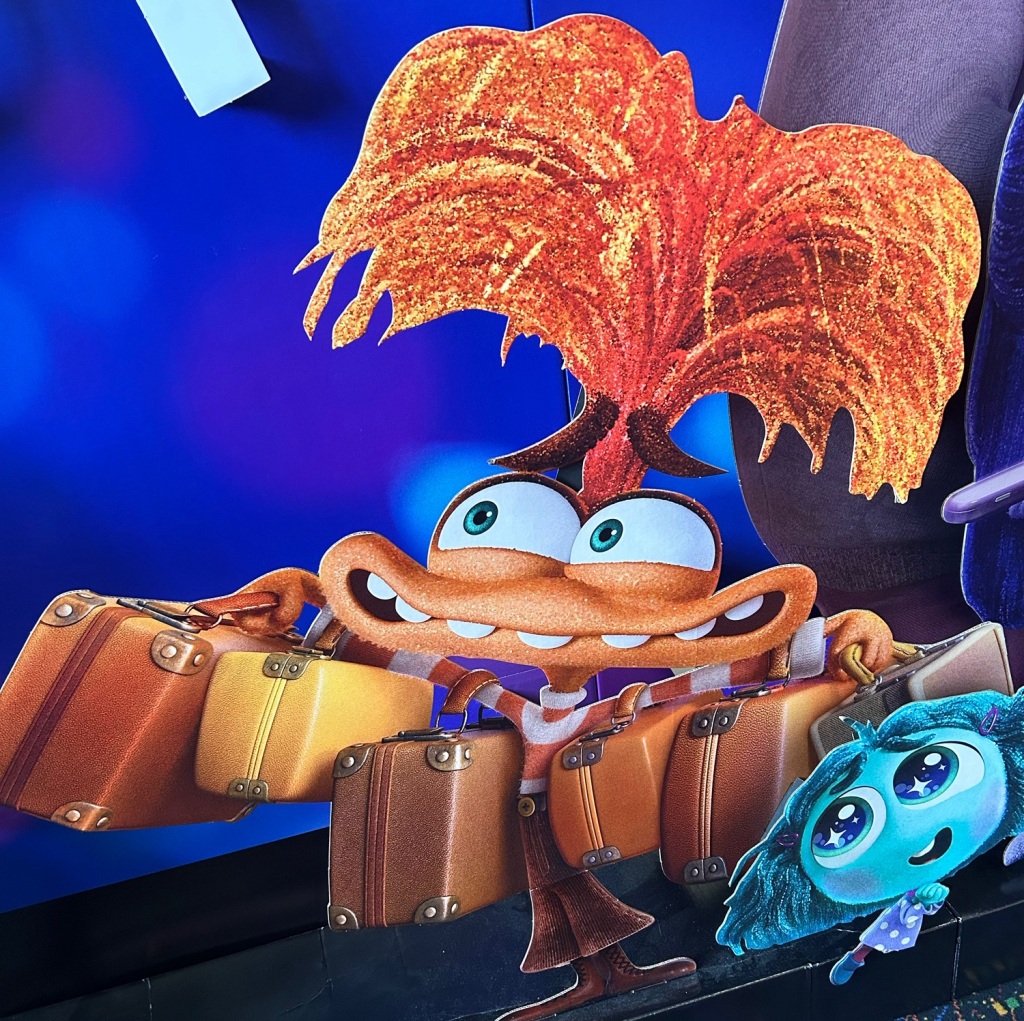
🚨 SPOILER ALERT: THIS POST CONTAINS PLOT DETAILS FROM THE NEW MOVIE “INSIDE OUT 2.” PROCEED AT YOUR OWN PERIL — AND DON’T SAY I DIDN’T WARN YOU! ⚠️
When I saw that Anxiety was the new cast member in the “Inside Out” sequel, the feeling in my gut driving me to go see the thing immediately overrode my Anxiety about going to a crowded public movie theater in the summer when school’s out.
That’s not easy to do, in general, because Anxiety (yes, it warrants continued capitalization) has been my most powerful driving force since birth. And these days, during my “time of the month,” it’s basically my entire personality.
I joke that I’m going through “second puberty,” though the hormonal mayhem of perimenopause has hardly been funny. You have to understand: I only recently started feeling my feelings when I stopped drinking to self-medicate Anxiety just under 5 years ago. So while I look mature, I’m kind of a combo teen/toddler when it comes to emotional regulation.
When we walked into the theater last Wednesday, my period was due any minute; consequently, the vigorous heartstring-tugging I expect from all PIXAR movies completely rocked my world this time around. The crying babies in the audience had nothing on me; I had to physically strain to keep my visceral reaction in check. It was so strenuous that I left with a splitting headache.
To quote the Disgust character: “Overreact much?”
“Inside Out 2” review: 😭😭😭😭😭😭😭😭 (that’s 8) out of 10. It wasn’t a perfect movie, but its representation of Anxiety as a rabid, relentless go-getter that can completely hijack the personality and dismantle the sense of self (if we let it!) was 100% spot-on. 🎯
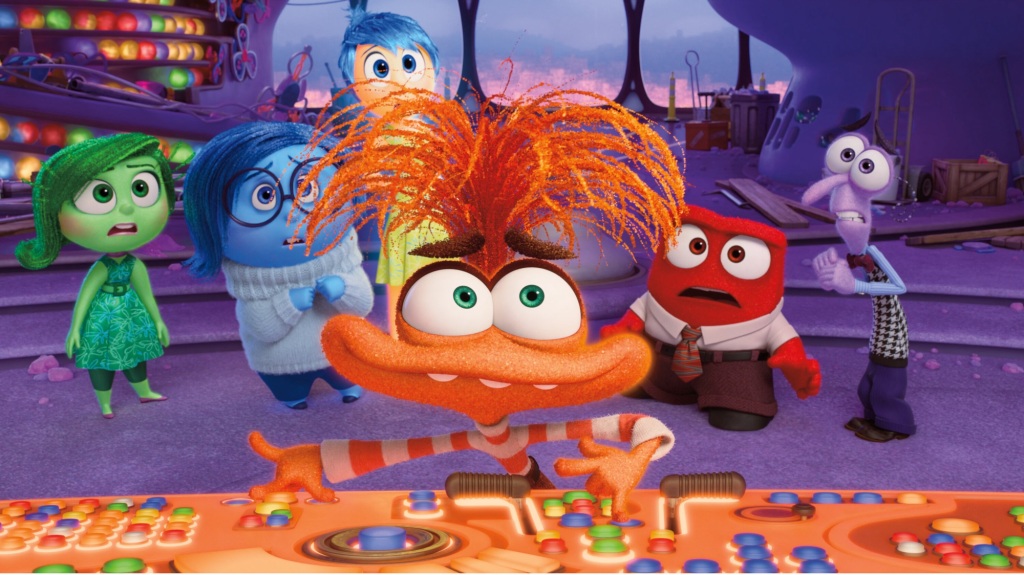
I’m sure anyone who lives with Anxiety can/will relate and connect with this film. For my part, I can honestly say I’ve never felt so seen in the cinema. I mean, up until the point where Riley, the teenage protagonist, magically figures out how to cope with her Anxiety and morphs from a tortured “try hard” into an easy-breezy member of the cool kid clique, I felt like I was watching the story of my life.
If I had a bunch of colorful animated emoticons bopping around in my brain as I sit here reflecting on that story, Sadness would be standing at the control board, channeling her cousins Grief and Regret.
I hurt for the little girl I was and wish I could go back and tell her everything I know now.
I wish I could hug her and say, quoting the Joy character in the movie’s final line: “No matter what, we love our girl.” 😭😭😭😭😭😭😭😭😭😭♾️
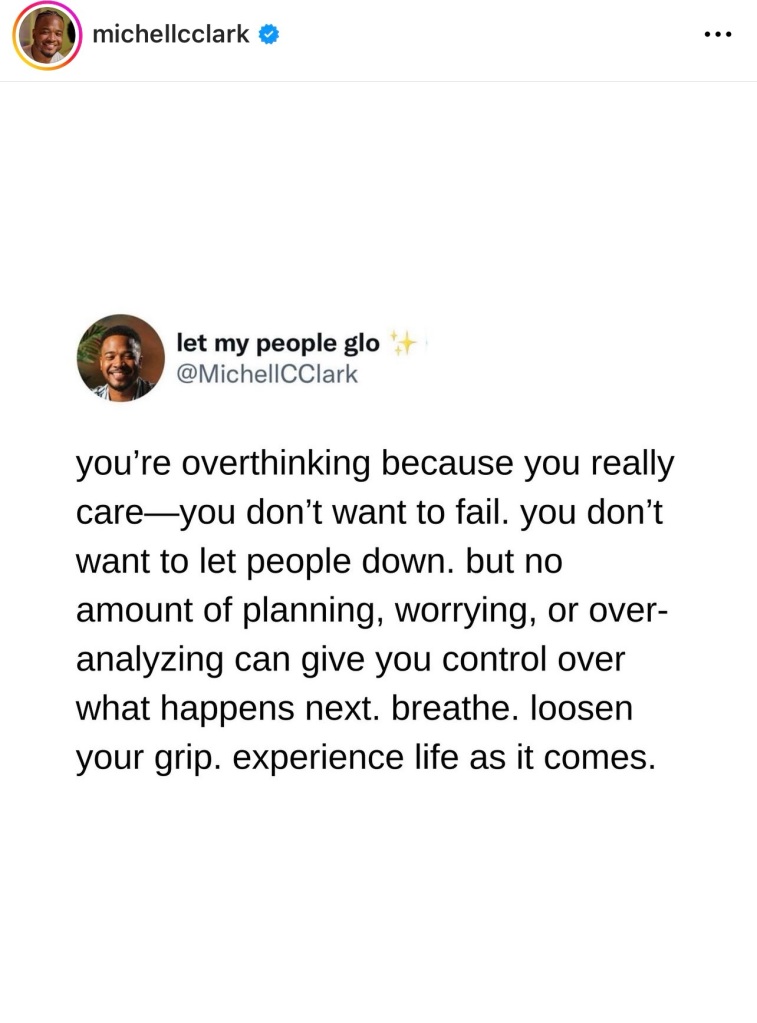
This post wasn’t meant as an “Inside Out 2” recap, but some context is required to understand Anxiety’s role and why it’s so relatable.
If you saw the original movie, you remember Riley; well, part deux meets her at age 13, a high-achieving, sports-loving girl who also happens to be tall, blonde and blue-eyed — with braces, which is one thing I didn’t relate to (thanks, Mom and Dad! 😐), and two best friends from whom she is inseparable.
That also feels a little foreign, but we won’t get into that now.
Riley is just starting to transition between middle and high school when she is blindsided by the onset of puberty in the middle of the night before she’s about to go to a prestigious hockey camp with her besties. (Later, Riley’s friends unexpectedly inform her that they “got assigned” to a different school for 9th grade and camp will be their last hoorah together on the ice.) In a flash, the control board in Riley’s brain, previously dominated by Joy, with the support team of Sadness, Anger, Fear and Disgust, gets dialed up to 11 in the sensitively department during a hostile takeover by Anxiety and her sidekicks (Envy, Embarrassment, and Ennui, which I guess is French for “meh.”)
Anxiety is bright orange, the color of radioactivity ☢️, has frizzy hair to match the crazed look in her eye, and a stiff, nervous grin that’s more cringey than happy 😬. She brings everything she owns (she’s prepared for every possible scenario!) She guzzles energy drinks, talks nonstop and really fast (she’s desperately driven to enact her plans, and she’s gotta be hypervigilant to perfect each detail and spot/stay ahead of any potential snafu!) And in an effort to protect Riley from the great adolescent danger of social isolation, Anxiety turns the poor kid into a performance monster who’s hellbent on gobbling up external validation at all cost.
She does this by dismantling Riley’s little girl self-concept, replacing core beliefs like “I am a good person/friend,” with “I’m not good enough,” and “If I’m good at hockey, I won’t be alone.” Anxiety commandeers Riley’s imagination so that the natural “goofball” foresees only catastrophic consequences to her joyful, childish whims. And in the throes of Anxiety, Riley throws away her entire value system and throws off major “follower” energy. She coldly shuns her old pals to fit in with the aforementioned “cool kids,” acting like a bona fide mean girl at times. Riley puts a red streak in her hair to look just like her idols, changes the way she walks, lets everyone go around calling her “Michigan,” when she’s from Minnesota, and worst of all, she pretends not to like her favorite boy band just to seem more “grown up.” 🙊
Moral of the (very true) story: You are not you with Anxiety running the show.
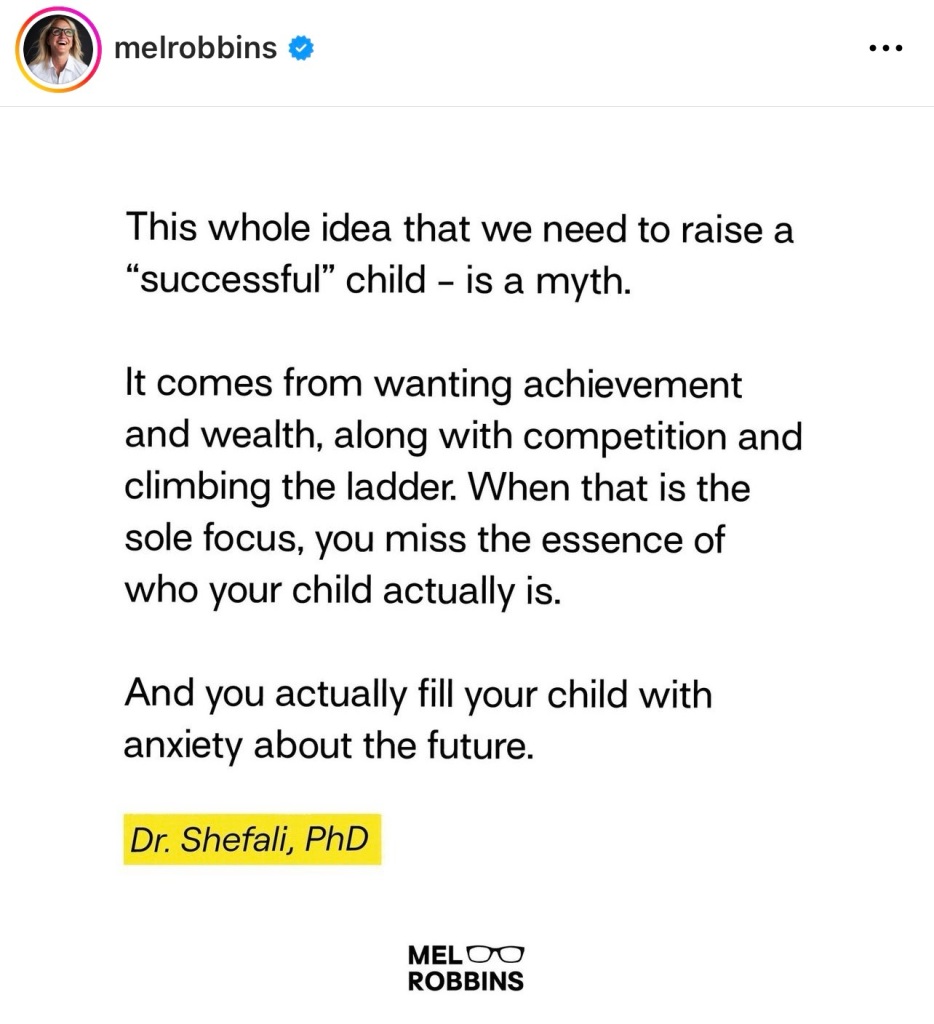
Source: @melrobbins on Instagram
Ultimately, we arrive at the movie’s main message: All emotions matter and play an important part in our personhood. None of them is “bad.” The key is to recognize them, listen to them, appreciate what they are trying to tell us, and integrate and manage them as we go about the business of living our lives.
While Anxiety does seem like an evil entity we would want to eradicate by any means necessary, fighting off the intense discontent she brings through self-medication, perfectionistic striving, people-pleasing, or other obsessive distractions, she is an integral part of us that must be approached with compassion. She is a highly motivated yet benevolent protector who is easily confused and can quickly run amok, wanting to help so bad that it often hurts. Anxiety banishes Joy in the pursuit of safety and comfort, and we have to accept, embrace, and learn to manage her to bring our whole being into balance. How we handle it when she barges in, uninvited, will directly impact our ability to maintain healthy functioning, sustain strong relationships, and cultivate self-love, en route to finding peace and happiness.
Coping does not always look like it did on screen, with Joy and Co. gently coaxing Anxiety into a comfy recliner with a cup of tea (Anxie-tea…get it?) when they see her getting ramped up to go all “runaway train.”
That’s the goal, no doubt, and these days, I’m closer than I’ve ever been before. But it took a lifetime of trial and error, and education, and therapy, and time in recovery, to put Anxiety in perspective — and in her proper place.

For me, in my youth, coping with Anxiety looked like constantly seeking solitude. Unlike Riley, an only child who craves companionship, I had all I could handle with the hyperactive goings-on inside my brain. Anything or anyone on the outside seemed too unpredictable, and thus, overwhelming, and the only way I knew to soothe myself was to go off by myself and escape into imagination — usually while moving my body, often via bike or skates, but sometimes just on foot. I would talk or sing out loud, making up/acting out stories or pretending I was a character in a movie or a book.
Who needs other kids when you’ve got creativity, was apparently my credo. 😬
Meanwhile, I was caught in a never-ending chase for external validation, believing it was my job to impress any adult who entered my orbit — or else. My version of Riley’s inner monologue was, “If I’m good at everything, I will be worthy of love,” and whether it was parents, pastors, teachers, coaches, Girl Scout leaders, art contest judges, my grandpa or great aunt, I approached each interaction as an opportunity to perform. I didn’t understand it at the time, but Anxiety had crossed my wires — as she does to Riley in the movie — to view achievement and approval as the antidote to everything I feared.
Yes, it sounds weird, but even as a kid, I had an innate sense of existential dread. It was a vague but nagging awareness of a great empty abyss, the threatening idea that life might be completely meaningless and our best efforts all for naught. This deeply saddened and terrified me — and understandably so. It seemed plausible to my baby brain that if I gobbled up as much positive attention as humanly possible, I could fill up that hole for good, and then, my existence would make sense!
That approach culminated in eating disorders when the transition from high school to college proved too much of a culture shock and my “giftedness” became pretty much the norm. Anorexia was, for a time, a really effective way to keep Anxiety occupied and distracted from the wide-open new world she (I) was scared to face. Ruminating on calories in/out, obsessing over every tiny wrinkle or bulge on my body, and plotting ways to avoid eating all day, every day, is a full-time job that leaves room for nothing else. Not the stuff you’re hiding from, but also not family, friends, finding your purpose or pursuing your passions…
Ditto for alcoholism, where that all-consuming obsession just transfers to securing the next drink. Although I never sought treatment to “get over” my eating disorder, I put it on the backburner when I needed energy to start working a real full-time job after college. Starving myself, or working out 3 times a day while popping Ex-Lax, was simply unsustainable. I switched to alcohol because it was there, and it was easy, and dammit, it worked!
It worked, like every other external “thing” humans reach for when we don’t know what to do about our physical/psychological/emotional issues, and we just want it all to go away. Booze, drugs, sex, technology, gaming, shopping, working, bingeing, starving, philandering, complaining…it works — until it very much doesn’t.
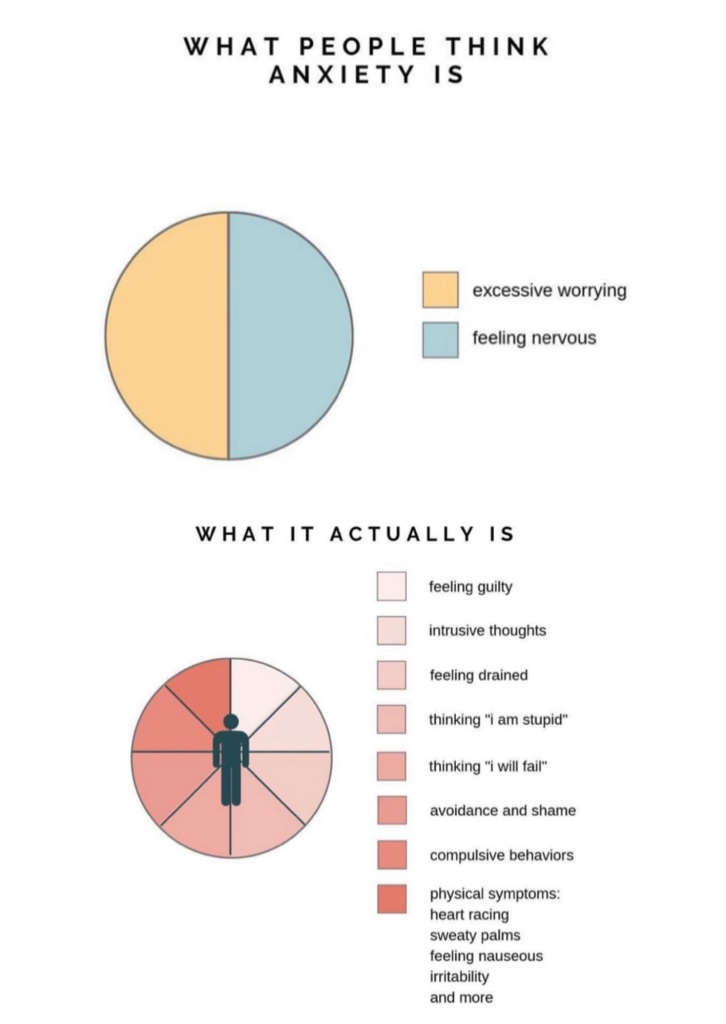
We learn as kids that alcohol is “bad for you,” then enter an adult world where its ugly, destructive, addictive reality is all gussied up with a pretty, bright, glittery sheen and sold, everywhere we look, as THE magic portal to a good life. THE golden ticket to pleasure. THE miracle cure for [fill in the blank with whatever you don’t want to feel]!
I came to believe alcohol was liquid Joy, and over time, that core belief solidified. Like in the movie, where Riley’s self-concept is filled with glowing harp strings that play statements she accepts as truths, my string said: “If I just keep on drinking, I’ll never feel pain!”
It can take a lot of time, hard work, and hard knocks to understand the link between Anxiety and our coping mechanisms, whether they’re “healthy” or harmful. You have to be willing to slow down, or stop, the vicious cycle you’re caught in and really take a hard look at yourself. You have to peek below the surface to figure out how the Inside has been shaping and driving whatever comes Out.
^ This is what happens in therapy, for all y’all who still think it’s for nutjobs and degenerates! Therapy is where someone like Riley would learn to ground herself during a panic attack, like she does in the movie’s climax, using the feel of the solid wooden bench on her hand and the warm sun streaming through the window onto her face to regulate her nervous system. (That’s ecotherapy, y’all! 😎)
Because she employs a healthy coping strategy in the moment, she is able summon the sense of Joy she knows she has inside to channel her pure love of hockey and get back in the game after a difficult setback.
In (or around) that scene at the camp scrimmage, as Anxiety drives Riley off the rails in her quest to “be good at hockey” by scoring a hat trick, and Riley’s other emotions think the fight is hopelessly lost and they’re on their way to extinction, Joy says, “Maybe when you grow up, you just experience less Joy.”
That might have been the movie’s most sob-worthy moment, had I not already cried myself out by that point.
Growing up, for me, has meant coming to terms with my Anxiety and all the ways I’ve let it run my life. I feel Sadness, and Regret, that I didn’t step up and take control before my 40s when I could’ve really reveled in some pre-menopausal years 🫤, but it brings me Joy when I think about the progress I have made in the past five!
I got a hold of my eating disorder and finally achieved some balance with regard to my body. I quit drinking and finally started to build a foundation for long-term mental and emotional stability. I went to therapy and gained a deeper understanding of who I am and how my mind works. And though Anxiety, along with her BFF Sensitivity, still looms large over every aspect of my life, I am learning to work with them, rather than against them.
Yes, that involves lots of tea and comfy resting spots! ☺️
I know now that I did what I did in the past to get by, at the service of my core belief system, because I didn’t know what else to do or how to change those beliefs. My issues are not my (or anyone else’s) fault, but they are my responsibility. Knowing better means I can do better, and as a professional therapist, I can even help others to heal so they can avoid the pitfalls I fell into myself. ⬅️ That, as the existentialists and 12-steppers believe, is how one creates meaning in life!
Now that the experience of Anxiety, and what happens to “a good person” when Anxiety takes control, has been masterfully depicted in a PIXAR movie, I’m hoping the Disney-loving family that has said things to me like, “Why can’t you just quit?” regarding my drinking, and “What do you have to be anxious about? You were always so good at everything!” might be a little closer to getting the picture.
But honestly, that doesn’t matter, because to quote a maxim I’ve often heard in AA, “Happiness is an inside job.” Every girl wants to know she’s loved, no matter what, but when she finally learns to give that love to herself, not even an over-the-top control freak like Anxiety can hold her back. 💪🏻
